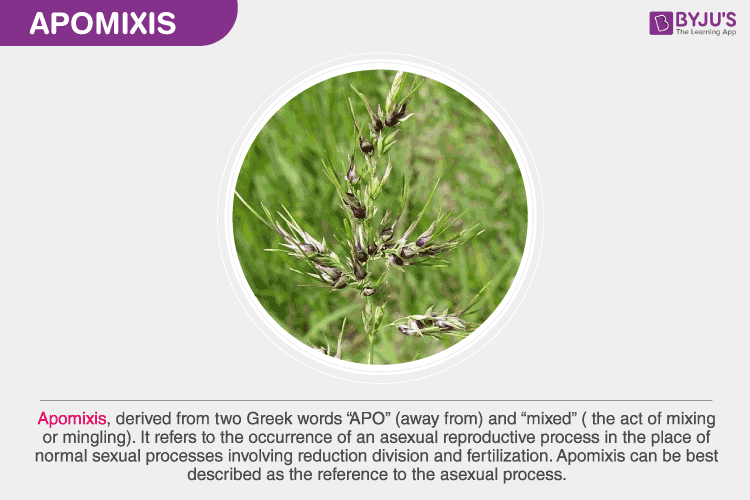
Table of Contents
Introduction
Apomixis is derived from two Greek words “APO” (away from) and “mixed” ( the act of mixing or mingling). It refers to the formation of the plant from a seed without fertilization or normal sexual reproduction. Apomixis can be best described as a reference to the asexual process. The plant produced is a clone of the female parent plant.
During sexual reproduction, developmental steps occurring inside the ovule produce the female gametophyte (embryo sac) and following a double fertilization event give rise to embryo and endosperm structures.
Apomixis is very common in higher plants. Plants of more than 35 families are known to be apomictic, e.g. Gramineae, Rosaceae, Compositae and Rutaceae. Major cereals such as maize and wheat show apomixis.
Types of Apomixis
Three types of apomixis are generally recognized – diplospory, apospory and adventitious embryony.
Diplospory
- In diplospory, the embryo sac is derived from the megaspore mother cell either directly by mitotic division or by interrupting meiosis.
- In the mitotic diplospory, the megaspore mother cell divides mitotically thrice to form 8 nuclei. The embryosac is unreduced and have same number of chromosomes and genetic material.
Apospory
- In apospory, the nucellar cells give rise to the apomictic embryo sac.
- It is the most common type of apomixis in higher plants.
- Aposporous initial cells differentiate and undergo mitosis to produce an embryo sac.
- Sometimes multiple embryo sacs may be found.
- The initiation of the apospory embryo sac and the sexual one can occur simultaneously or it can displace or interrupt sexual embryo sac formation.
Adventitious Embryony
- It is a type of sporophytic apomixis, where embryos are produced directly from the nucellus or the integument of the ovule.
- The embryo develops by mitotic division and forms a bud-like structure.
Simultaneous fertilization in the adjoining sexual embryo sac is required to form viable seeds. The developing embryos grow towards it to obtain nutrients and signals from the embryo sac.
There are a few further types of apomixis which are discussed in brief below.
Recurrent and Non-recurrent Apomixis
- In recurrent apomixis, both the egg cell and embryo are diploid and the embryo sac is developed from the megaspore mother cell.
- In non-recurrent apomixis, both the egg cell and embryo are haploid and the embryo is developed directly from an egg cell without fertilization.
Vegetative Apomixis
- In this apomixis type, vegetative bulbils or buds are produced in the inflorescence instead of flowers.
- They are easily reproducible and are seen in certain plants like Fragaria, Agave, Poa bulbosa, etc.
Benefits of Apomixis
- It helps in hybrid seed production.
- It is one of the most cost-effective methods to produce seeds.
- Apomixis prevents the loss of specific characters in the hybrid.
For more such biology lessons, stay tuned with BYJU’S.

Wow it’s amazing. I easily understood the topic which I want to learn without any problem. ⭐⭐⭐